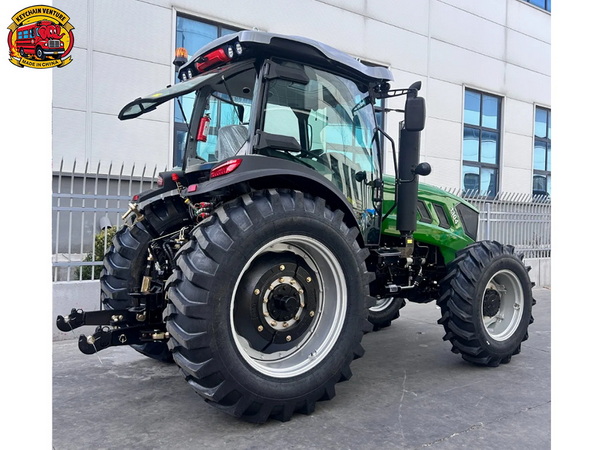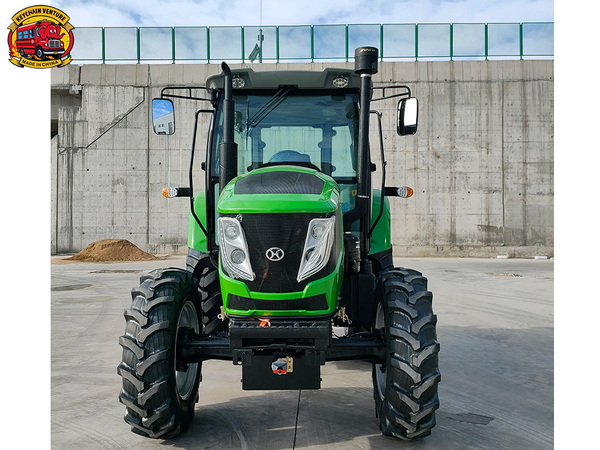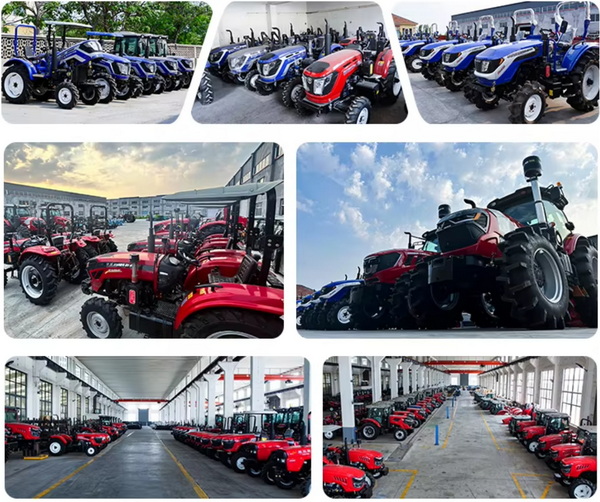Views: 222 Author: Amanda Publish Time: 2025-08-20 Origin: Site








Content Menu
● Assess Your Needs Before Buying a Used Tractor
● Evaluate the Tractor's Physical Condition
● Check the Engine and Powertrain
● Understand the Tractor's Specifications
● Inspect Hydraulic and Electrical Systems
● Review Maintenance and Repair History
● Test Drive and Performance Check
● Additional Considerations When Buying a Used Tractor
>> Fuel Efficiency and Emissions Compliance
>> Availability of Replacement Parts and Accessories
>> Operator Comfort and Safety
>> Resale Value and Brand Reputation
● Consider Warranty and After-sales Support
● Price Negotiation Tips for Used Tractors
● Common Mistakes to Avoid When Buying a Used Tractor
>> 1. How do I know if a used tractor is in good condition?
>> 2. What is the average lifespan of a used tractor?
>> 3. Should I buy a used tractor from a private seller or a dealer?
>> 4. What maintenance should I perform immediately after buying a used tractor?
>> 5. Can I finance a used tractor purchase?
Purchasing a used tractor can be a highly cost-effective way for farmers, construction companies, and commercial vehicle operators to obtain reliable machinery without the high upfront costs of new equipment. However, buying a used tractor requires careful evaluation to ensure you get a machine that meets your needs and performs efficiently over time. At KeyChain Venture Co., Ltd., a leading Chinese commercial vehicle supplier providing high-performance bus and heavy truck solutions worldwide, we understand the critical factors that buyers should consider.
In this comprehensive guide, we will walk you through everything you need to know about buying a used tractor, from evaluating the machine's condition to understanding key features, technical specifications, and potential risks. Whether you are a first-time buyer or an experienced operator, this article will equip you with the knowledge to make an informed decision.

Before starting your search for a used tractor , it is essential to clearly identify your operational requirements. Different tractors come with varying horsepower, implements compatibility, and purposes such as agriculture, construction, or hauling heavy loads.
- Determine the Tractor Size and Horsepower: Smaller tractors (30-60 HP) are ideal for lighter farm tasks or landscaping, while larger tractors (above 100 HP) can handle heavy-duty plowing and hauling.
- Consider Terrain and Soil Conditions: Rough or hilly terrain requires a tractor with good traction, possibly four-wheel drive.
- Compatibility with Attachments: Verify that the tractor supports the implements you need, such as loaders, mowers, or backhoes.
- Usage Frequency: Consider whether you require the tractor for daily heavy use or occasional tasks to select the appropriate durability level.
This initial assessment will narrow down your options and make the buying process more focused.
When inspecting a used tractor , the physical condition is your first indicator of its overall health. Since the tractor's body often takes the brunt of usage, a close visual inspection is mandatory.
- Exterior Inspection: Look for significant dents, rust, or structural damage on the chassis. Rust near joints or welds could be a sign of neglect.
- Tires and Wheels: Check for uneven tire wear or cracks in the tires. Worn tires can indicate heavy use and might require replacement soon. Also, inspect wheel rims for dents or bends that might affect safety.
- Cab and Controls: Ensure the operator's seat, steering wheel, and dashboard controls are intact and functional. Verify that gauges, levers, and switches respond smoothly without unusual stiffness or looseness.
- Frame and Loader Arms: Look for cracks or repairs in the frame which could compromise safety. Check for any welding marks or signs of frame distortion indicating previous accidents.
- Cleanliness: A clean tractor often reflects better maintenance habits, but be cautious if the seller has cleaned it excessively to hide defects.
If possible, ask for recent photographs or videos from multiple angles to assess these physical aspects during remote inspections.
The engine is the heart of any tractor. A well-maintained engine ensures a used tractor runs reliably and handles demanding tasks.
- Inspect Engine Oil: Clean oil and proper levels indicate good maintenance. Dark or gritty oil is a warning sign of wear or neglect.
- Look for Leaks: Oil, coolant, or fuel leaks are red flags and generally require costly repairs. Pay attention to wetness around seals and gaskets.
- Examine the Air Filter and Radiator: These components should be clean and free from blockages or damage that could cause overheating.
- Listen to Engine Noise: Unusual knocking or rattling sounds during startup or idle may indicate internal problems such as worn bearings or piston issues.
- Check Exhaust Smoke: Excessive black smoke signals poor combustion, while blue or white smoke suggests burning oil or coolant leaks.
- Transmission and Clutch: Ensure the transmission shifts smoothly through all gears without slipping or jerking. A slipping clutch or delayed gear engagement requires immediate attention.
Taking time to perform a detailed engine evaluation is critical, as engine repairs are often the most expensive.
Knowing the technical specifications is crucial for matching a used tractor to your workload and ensuring compatibility with your operations.
- Horsepower and Torque: Higher horsepower tractors provide more power but consume more fuel. Select the horsepower that is appropriate for your typical tasks.
- Fuel Type: Diesel engines dominate due to their fuel efficiency and strong torque output, essential for heavy-duty farm and industrial applications.
- Hydraulic Capacity: Determines how well the tractor powers hydraulic implements. High hydraulic flow rates are necessary for more complex attachments.
- PTO (Power Take-Off) Speed and Type: Vital for attaching implements like mowers, tillers, and harvesters. Common PTO speeds include 540 and 1000 RPM.
- Weight and Size: Larger and heavier tractors provide stability and traction but may be less maneuverable on small fields or tight construction sites.
- Drive Type: Two-wheel drive (2WD) tractors are less expensive and simpler but four-wheel drive (4WD) models provide improved traction and are preferable for challenging terrains.
Obtaining the model's datasheet or operator's manual will help you verify these specifications and ensure the used tractor aligns with your requirements.

Hydraulics and electrical controls support many modern tractor functionalities. It's essential to confirm these systems' integrity before buying a used tractor .
- Hydraulic System: Look for leaks in hoses and cylinders, check hydraulic fluid levels, and operate hydraulic controls to verify smooth lifting and lowering. Hydraulic failures can significantly impede implement use.
- Electrical System: Test the battery condition, headlights, dashboard instruments, starter motor, and any onboard electronics. Corroded terminals or flickering lights indicate electrical issues.
- Wiring and Connectors: Examine wiring harnesses for signs of corrosion, frayed wires, or amateur repairs. Faulty wiring can lead to unpredictable malfunctions.
- Safety Features: Confirm the operation of horn, brake lights, and emergency shutdown controls for operator safety.
These systems are often costly and complex to repair, so a thorough check is worthwhile.
One of the most strategic ways to gauge the condition of a used tractor is by reviewing its maintenance log and repair history.
- Scheduled Service Records: Regular oil changes, fluid replacements, and inspections indicate responsible ownership.
- Parts Replacement History: Inquire about the age of critical consumables such as belts, hoses, filters, tires, and brake components.
- Warranty or Service Contracts: Check if any manufacturer or dealer warranty remains, or if service contracts can be transferred.
- Previous Accidents or Major Repairs: Ask for disclosure about accidents or overhauls that might affect structural integrity or longevity.
- Usage Patterns: Tractors primarily used in harsh conditions may suffer more wear than those used sparingly.
If the seller cannot provide detailed records, consider it a red flag and weigh other options carefully.
Nothing beats a hands-on test drive when evaluating the operational soundness of a used tractor .
- Start-Up Check: Observe how quickly and smoothly the engine fires up. Rough starts or long cranking times may indicate electrical or engine problems.
- Gear Shifts: Cycle through all gears and ranges, listening for grinding or hesitation which could signal transmission trouble.
- Braking Performance: Test brakes for responsiveness and smooth stopping. Weak or noisy brakes compromise safety.
- Steering and Handling: Ensure steering wheel movements translate smoothly to tractor direction. Excessive play or stiffness should be investigated.
- Attachment Operation: If possible, test hydraulic lifts, front loaders, and PTO attachments to confirm proper functioning.
- Idle and Load Behavior: Monitor engine performance at idle and under load to detect power loss, overheating, or abnormal noises.
If you lack expertise, consider bringing an experienced mechanic or tractor inspector to support your evaluation.
Fuel costs contribute significantly to overall ownership expenses. Investigate the tractor's fuel consumption rates under typical workloads. Additionally, ensure the tractor complies with relevant environmental regulations, especially if you operate in regions with strict emission standards. Modern used tractors often come equipped with emission control technologies such as diesel particulate filters or exhaust gas recirculation systems.
Before finalizing your purchase, verify the availability and cost of replacement parts for the tractor model you intend to buy. Reliable sourcing of filters, belts, tires, and hydraulic components ensures that maintenance remains manageable. Some older or less common tractor models may pose challenges due to scarce spare parts, leading to prolonged downtime.
Operator comfort can directly influence productivity during long working hours. Review the ergonomics of the cab or platform, including seat adjustability, visibility, noise levels, and climate control (if applicable). Also, verify the presence and functionality of safety features such as rollover protective structures (ROPS), seat belts, and emergency shut-off mechanisms.
Consider the tractor's brand reputation for reliability, ease of maintenance, and market demand. Well-known brands typically retain higher resale values, making them better long-term investments. This is particularly important if you plan to upgrade or resell the tractor in the future.

Buying from a reputable dealer or supplier can offer peace of mind and greater confidence in your used tractor purchase.
- Warranty Options: Some dealers provide limited or extended warranties on used equipment, which can cover major repairs for a set time.
- Spare Parts Availability: Choose suppliers with a robust supply chain that guarantees easy access to parts.
- After-sales Service: Look for dealers who offer servicing, technical support, and operator training.
- Financing and Trade-in Programs: Some companies facilitate financing or trade-in deals, easing your purchasing process.
At KeyChain Venture Co., Ltd., we emphasize service quality and customer support alongside product performance, ensuring clients have a reliable partnership beyond the initial sale.
Pricing for used tractors depends on market demand, condition, brand, and included features. Effective negotiation tactics include:
- Research Market Value: Consult online listings, industry price guides, and recent sale advertisements to understand fair prices.
- Point Out Flaws: Use minor defects, wear, or needed maintenance as leverage to negotiate a better price.
- Consider Total Cost of Ownership: Include estimates for repairs, servicing, and consumables in your budget.
- Bundle Deals: If purchasing multiple units or attachments, ask for price reductions or added value.
- Be Prepared to Walk Away: If the price or unit condition doesn't meet your criteria, do not hesitate to explore other options.
Patience and information are your best allies during negotiation.
1. Skipping a Thorough Inspection: Never buy without a full inspection, including test drive. Hidden issues can become costly problems.
2. Ignoring Operational Needs: Avoid purchasing a tractor that doesn't meet your power, size, or attachment compatibility requirements.
3. Neglecting Maintenance History: Always demand documented service records to understand the tractor's true condition.
4. Overlooking Hidden Damage: Rust, frame damage, or substandard repairs often lead to decreased lifespan and safety risks.
5. Not Considering Resale Value: Think about brand reputation and demand to protect your investment's future value.
Avoiding these mistakes will save you time, money, and frustration.
Buying a used tractor can be a smart investment when approached with knowledge and caution. Understanding your operational needs, carefully inspecting the tractor's physical and mechanical condition, reviewing maintenance history, and negotiating wisely are key steps to ensure you get machinery that performs reliably for years. Remember, partnering with a trusted supplier who offers quality products and after-sales support is equally important for sustaining your operations.
At KeyChain Venture Co., Ltd., we are proud to offer a wide range of high-performance commercial vehicle solutions, including reliable tractors for domestic and international clients. Our expert team is ready to assist you in finding the best match for your business needs.

Check for signs of rust, leaks, proper tire wear, engine oil quality, hydraulic system operation, and test drive performance. Request maintenance records and consider professional inspections to get an accurate evaluation.
A tractor's lifespan depends on usage and maintenance but typically ranges from 8,000 to 12,000 operating hours or 10-15 years under normal conditions.
Dealers usually offer warranties, inspections, and after-sales support, providing more security, while private sellers may offer lower prices but less assurance.
Immediately change engine oil and filters, inspect hydraulic fluid levels, check tire pressure, and conduct a full system diagnostic to address any existing issues.
Many dealers and lenders provide financing options for used tractor purchases, with terms varying based on supplier and buyer creditworthiness.